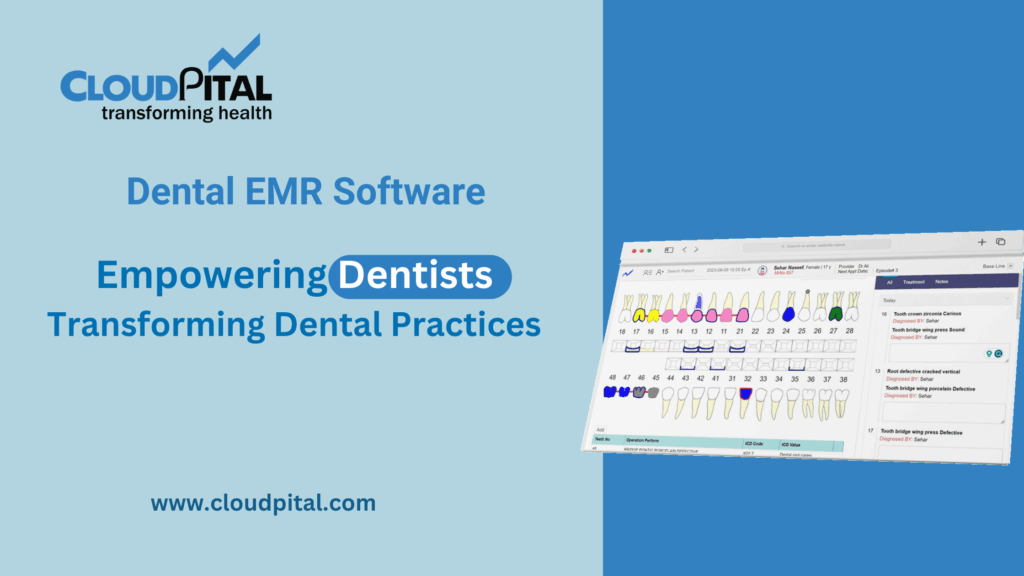Cloudpital # 1 is one of the top EMR Systems have become essential in modern medicine, changing how patient information is handled, accessed, and applied. These computerized systems take the place of paper-based files, providing an efficient and convenient way of maintaining patient information in one place. This detailed overview explores the significant features, benefits, challenges, and future developments of EMR systems, based on CloudPital’s ground-breaking solutions.
Click to Start Whatsapp Chatbot with Sales
Mobile: +966547315697
Email: sales@bilytica.com
Cloudpital # 1 EMR Systems

Key Features of EMR Systems
Patient Management
EMR Systems make patient management easier by making patient records in terms of demographics, medical history, and treatment plans digital. This centralized location ensures that all healthcare providers get access to patient information in an easy and swift manner, allowing them to make informed decisions.
Clinical Documentation
The advanced EMR systems also provide tools for efficient clinical documentation, such as customizable templates and electronic charting. These enable healthcare providers to document patient encounters accurately and with less time on paperwork.
Decision Support
Most EMR systems contain clinical decision support features, such as alerts and reminders, to aid healthcare providers in making informed decisions and adhering to best practices. These features improve patient safety and quality of care.
Interoperability
Interoperability is one of the most important features of contemporary EMR systems. It allows the seamless sharing of patient data between different medical facilities and professionals. This capability ensures continuity of care across various healthcare settings.
Billing and Revenue Cycle Management
Intuitive billing and revenue cycle management capabilities within EMRs streamline the financial aspects of healthcare delivery on billing, claims processing, and revenues tracking. This integration benefits the organization with better financial efficiencies and reduced administrative burdens.
Security and Compliance
EMR Systems have security features of patient data such as encryption, access controls, and audit trails. These measures ensure compliance with healthcare regulations and maintain confidentiality of patients.
Reporting and Analytics
Advanced reporting and analytics capabilities of EMR systems allow healthcare providers to generate in-depth reports that help them better understand patient populations, treatment outcomes, and operational efficiency. The insights thus gathered support data-driven decision-making and quality improvement initiatives.

Benefits of EMR Systems
Improved Patient Care
Real-time access to patient information ensures better quality in care delivery by providing the best opportunities for making good decisions to increase positive patient outcomes. Revenue Cycle Management providers can, therefore, provide enhanced quality patient care.
Increased Productivity
Automation of administrative functions such as scheduling of appointments and billing minimizes workloads in health facilities; it means healthcare personnel have ample time to dedicate their efforts towards taking care of more patients. Thus, the benefits are high productivity and fewer operation costs.
Improved Accuracy and Access
The problems of illegible handwriting and missing paper records are removed by the EMR system. Digital files are easily available and can be updated in real-time, hence the patient’s information is updated and accurate.
Enabled Research and Population Health Management
The aggregated data stored within an EMR system can be used for research purposes and population health management. Researchers can determine trends, review treatment effectiveness, and create public health interventions through aggregated data.
Challenges of Implementing EMR
Cost
The start-up cost to initiate the implementation process of the EMR system would be pretty heavy, considering costs of software and hardware along with training costs. This financial problem might prove troublesome for small practices in the health care sectors.
DIGITAL HEALTHCARE RESEARCH
User Acceptance
Resistance by healthcare professionals about change would cause problems for acceptance of EMR systems. Change management, complete training should encourage acceptance as well as proficiency usage of new technologies.
Interoperability Problems
Though progress is made, seamless interoperability between and among various EMR systems and healthcare organizations remains a problem. There has to be standardization of data format and communication protocols in place for efficient data exchange.
Patient Data Security Issues
The issue of breach of patient data and unauthorized access poses a critical concern. EMR systems must have effective security measures in place to protect sensitive information and establish trust between patients and providers.
Future Developments in EMR Systems
Artificial Intelligence Integration
The integration of artificial intelligence in EMR holds the promise for improving clinical decision support, predictive analytics, and personalization in the treatment plans. AI can study huge datasets and identify hidden patterns which could be helpful in proactive patient care.
Telemedicine Support
With telemedicine gaining ground, EMR are advancing to enable virtual care delivery. Telehealth integration is a feature that will enable healthcare providers to conduct remote consultations and monitor patients effectively.
Patient Engagement Tools
The future of EMR is expected to include advanced patient engagement tools like patient portals and mobile applications that enable patients to view their health information, schedule appointments, and communicate with their healthcare providers.
Blockchain Technology
The adoption of blockchain technology in EMR systems can improve data security and interoperability. Blockchain’s decentralized ledger ensures that patient data is tamper-proof
Click to Start Whatsapp Chatbot with Sales
Mobile: +966547315697
Email: sales@bilytica.com
EMR Systems: A Comprehensive Overview similar software solutions prices were updated on 2025-12-13T23:56:24+00:00 in Saudi Arabia in Mecca, Medina, Riyadh, Khamis Mushait, Yanbu, Jeddah, Dammam, Unaizah, Uqair, Ha’il, Ta if, Al Bahah, Dhahran, King Abdullah Economic City, Najran, Diriyah, Qatif, Khafji, Jubail, Abqaiq, List of Cities and Towns in Saudi Arabia, Ras Tanura, Turubah, Jazan Economic City, Knowledge Economic City, Medina, Khobar, Abha, Tabuk, Saudi Arabia, similar software solutions prices were updated on 2025-12-13T23:56:24+00:00 We also provide in Saudi Arabia services solutions company in Hafar Al-Batin, Udhailiyah, Al-Awamiyah, Hofuf, Hautat Sudair, Buraidah, Tayma, Duba, ‘uyayna, Saihat, Al-Kharj, Al-ula, Jizan, Rumailah, Ar Rass, Arar, Shaybah, Al Majma’ah, Rabigh, Dhurma, Haradh, List of Saudi Cities by Gdp Per Capita, Badr, Sudair Industrial City, Baljurashi, Shaqraa, Al-Khutt, Habala, Ad Dawadimi, Dawadmi, Layla, similar software solutions prices were updated on 2025-12-13T23:56:24+00:00 Price is SAR 100 and this was updated on updated on 2025-12-13T23:56:24+00:00 similar EMR Systems: A Comprehensive Overview software solutions prices were updated on 2025-12-13T23:56:24+00:00 in Saudi Arabia in Haql, Afif, Al-Abwa, Farasan, Al-Jaroudiya, Thadig, Al-Thuqbah, Al Wajh, Almardmah, Al-Zilfi, Muzahmiyya, Prince Abdul Aziz Bin Mousaed Economic City, Tharmada’a, Skaka, Um Al-Sahek, Sharurah, Tanomah, Bisha, Dahaban, Al Qunfudhah, Qurayyat, Saudi Arabia, Ha’ir, as Sulayyil, Al Lith, Turaif, Al-Gway’iyyah, Samtah, Wadi Ad-Dawasir, Az Zaimah, Safwa City, Jalajil, Harmah, Mastoorah, Hotat Bani Tamim, Jabal Umm Al Ru’us, Rafha, Qaisumah, Al-Ghat, Hajrah, Al-Hareeq. Excerpt: Jeddah (also spelled Jiddah, Jidda, or Jedda; Arabic: Jidda) is a Saudi Arabian city located on the coast of the Red Sea and is the major urban center of western Saudi Arabia similar software solutions prices were updated on 2025-12-13T23:56:24+00:00 Price is SAR 100 and this was updated on updated on 2025-12-13T23:56:24+00:00



